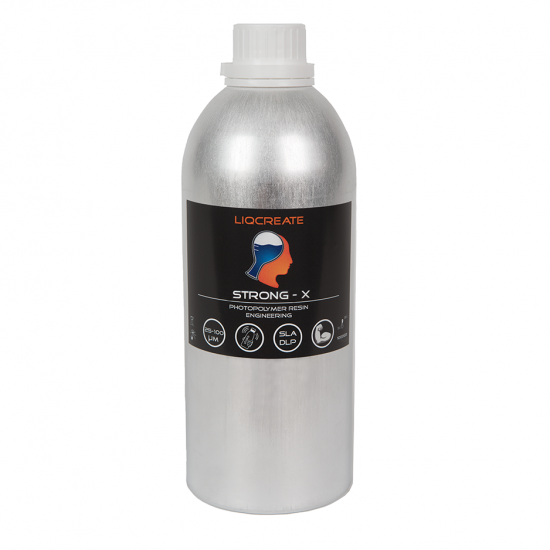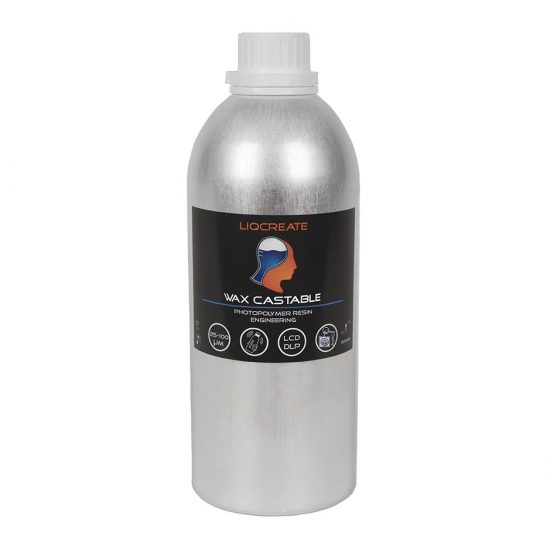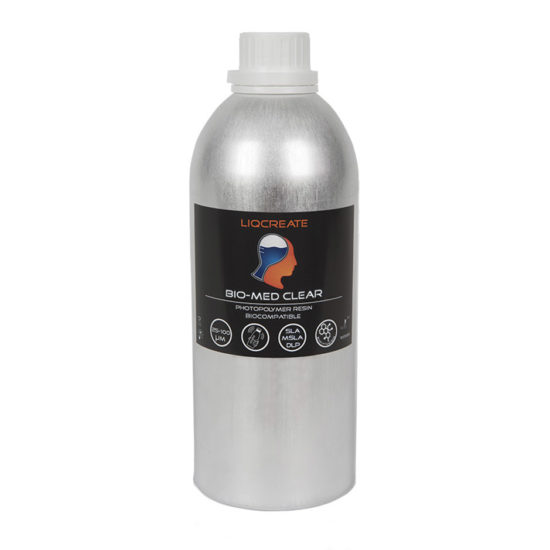All Liqcreate resins are UV-curable 3D-Printing resins, which means that they have a designed reactivity to specific light. This reactivity controls how the resins behaves in the printer and during UV post-curing. In this article we explained that specific parameters about its reactivity are the Critical Enegergy (Ec) and the Depth of Penetration (Dp), two values which can be found for all Liqcreate materials in their corresponding Technical Data Sheet. These two values are empirically derived values based on measurements using a 3D-printer. Before UV light intensity meters were expensive and only feasible for professional resin or hardware manufacturers to purchase. Now Chitu Systems (known from Chitubox) has developed an affordable UV meter. In this article we test it on different machines to see how it works and measure UV intensity and deviation of several resin 3D-printers.
What is the Chitu Systems 405nm UV-meter?
According to the manufacturer: “Portable UV intensity meter for resin 3d printers, 405nm LCD/DLP printers only. This an excellent and affordable tool to help you check out the status of the light source in your 3d printer.”
Additionally you can measure the deviation in light-output of your printer on different spots and use the values to calculate (theoretical) exposure times.

Image by Chitu Systems: Their new 405nm UV-meter tool to measure the UV intensity of resin based 3D-printers.
What is the UV power, stability and output of different printers?
We measured a bunch of 405nm LCD printers in our lab and used 9 measurements per printer to check its stability. These were measured across the build plate in a structural manner, 3 on the left side from top to bottom of the LCD screen, 3 in the middle and 3 on the right with the same structure. See the table below for the measurements. It should be noted that most printers are used quite some time and might have lost some of its power over-time. See the complete data-set in the appendix below.
| Printer | UV power of printer | Average power (mW/cm^2) | Deviation (%) |
| Photon M3 Plus | 100% | 7,06 | 5,9% |
| Photon M3 Plus | 75% | 5,97 | 3,1% |
| Photon M3 Plus | 50% | 4,46 | 4,1% |
| Photon Mono [1] | 100% | 4,63 | 6,3% |
| Photon Mono [2] | 100% | 4,71 | 3,7% |
| Photon Mono [3] | 100% | 4,72 | 8,8% |
| Photon Mono [4] | 100% | 4,65 | 6,1% |
| Photon D2 | 100% | 2,92 | 4,0% |
| Photon Mono SE | 100% | 5,51 | 7,4% |
| Photon Mono X | 100% | 7,32 | 4,1% |
| Anycubic Photon M5s | 100% | 4,54 | 7,1% |
| Phrozen Sonic Mighty 4K | 100% | 3,21 | 4,5% |
| Elegoo Saturn | 100% | 3,72 | 4,7% |
| Elegoo Saturn 3 | 100% | 4,07 | 9,4% |
| Elegoo Mars 2 | 100% | 3,69 | 8,4% |
| Elegoo Mars 3 | 100% | 3,32 | 9,3% |
| Creality Halot-One | 100% | 2,63 | 6,3% |
| Peopoly Phenom Prime | 100% | 5,35 | 6,2% |
Does the Chitu Systems 405nm UV-meter work?
From the first test executed with this measurement device, it looks like a nice and affordable tool to have around for a quick measurement.
How to calculate with Ec / Dp values in resin 3D-printing?
Reactivity to light is measured by exposing the resins with different doses of energy (Exposure), in most cases this is controlled by increasing the exposure time in the 3D-printer. Then the layer thickness of the cured resin is measured and plotted versus the corresponding energy input as seen in the figure below.
Because the resin will absorb the light and using its energy to start the solidification reaction, the cure depth will always be finite, leading to a logarithmic correlation between the exposure and the cure depth, a typical curve is shown in the figure above. [10]
The curve (working curve) is a visual representation of the correlation between printer and resin and based on this a mathematical correlation is derived, as shown in formula 1 with:
Cd = Cure Depth [mm] (layer thickness)
Dp = Depth of penetration [mm] (slope of Cd vs LogExp)
Ec = Critical Energy [J/mm2] (the minimal amount of energy required to form a solid layer)
Cd = Dp • In(Exp) + Ec
And where Exp = exposure [J/m2], which is a function of the exposure time calculated as shown in formula 2, with:
t = Time [s] (illumination time)
Irr = Irradiance [W/m2] (power of the lightsource)
Exp = t • Irr
So far the technical part about the curing behavior, but how do these parameter describe the behavior of resins in a 3D-printer from a more practical point of view?
The depth of penetration (Dp) shows a materials sensitivity to changes in light output, which means that a material with a lower Dp has better performance when subjected to variations in exposure time/light source power, while a material with a higher Dp, is more likely a faster printing material but also more sensitive for failure at deviations in light output. Whereas its seems that a faster printing resins is more preferable, a less sensitive resins is practice more useful, because of high likeliness in changes in light output due to lack of proper cleaning and degradation of the light source.
The critical energy (Ec) is a value for the minimum amount of energy required to form a solid layer and therefor the minimum amount of energy required for 3D-printing.
These values are derived from practical measurements, which means that they can vary when the parameters within the measurement are changed like temperature and wavelength.
UV meter chitubox raw data
| Printer | Photon M3 Plus | Gem | 7,064 | 9 spots: | |||||
| UV power | 100% | Min | 6,313 | 10,6% | 6,893 | 6,55 | 6,313 | ||
| date | 20-2-2023 | Max | 7,783 | 10,2% | 7,215 | 7,416 | 7,033 | ||
| STDEV | 0,41934 | 7,31 | 7,783 | 7,065 | |||||
| % STDEV | 5,9% | ||||||||
| Printer | Photon M3 Plus | Gem | 5,968 | 9 spots: | |||||
| UV power | 75% | Min | 5,57 | 6,7% | 5,57 | 5,903 | 5,955 | ||
| date | 20-2-2023 | Max | 6,318 | 5,9% | 6,071 | 6,318 | 5,855 | ||
| STDEV | 0,187402 | 6,042 | 6,008 | 5,986 | |||||
| % STDEV | 3,1% | ||||||||
| Printer | Photon M3 Plus | Gem | 4,464 | 9 spots: | |||||
| UV power | 50% | Min | 4,212 | 5,7% | 4,454 | 4,339 | 4,305 | ||
| date | 20-2-2023 | Max | 4,796 | 7,4% | 4,285 | 4,796 | 4,551 | ||
| STDEV | 0,185066 | 4,212 | 4,674 | 4,563 | |||||
| % STDEV | 4,1% | ||||||||
| Printer | Mono (1) | Gem | 4,631 | 9 spots: | |||||
| UV power | 100% | Min | 4,307 | 7,0% | 4,766 | 4,42 | 5,126 | ||
| date | 16-2-2023 | Max | 5,126 | 10,7% | 4,371 | 4,587 | 5,064 | ||
| STDEV | 0,29334 | 4,307 | 4,32 | 4,72 | |||||
| % STDEV | 6,3% | ||||||||
| Printer | Mono (2) | Gem | 4,709 | 9 spots: | |||||
| UV power | 100% | Min | 4,44 | 5,7% | 4,744 | 4,68 | 4,974 | ||
| date | 20-2-2023 | Max | 4,981 | 5,8% | 4,61 | 4,981 | 4,751 | ||
| STDEV | 0,17313 | 4,44 | 4,69 | 4,511 | |||||
| % STDEV | 3,7% | ||||||||
| Printer | Mono (3) | Gem | 4,721 | 9 spots: | |||||
| UV power | 100% | Min | 4,146 | 12,2% | 5,312 | 4,812 | 4,802 | ||
| date | 20-2-2023 | Max | 5,412 | 14,6% | 4,6 | 4,146 | 5,412 | ||
| STDEV | 0,41378 | 4,497 | 4,17 | 4,738 | |||||
| % STDEV | 8,8% | ||||||||
| Printer | Mono (4) | Gem | 4,654 | 9 spots: | |||||
| UV power | 100% | Min | 4,11 | 11,7% | 4,507 | 5 | 4,557 | ||
| date | 20-2-2023 | Max | 5,014 | 7,7% | 5,014 | 4,891 | 4,758 | ||
| STDEV | 0,284764 | 4,11 | 4,362 | 4,69 | |||||
| % STDEV | 6,1% | ||||||||
| Printer | Photon D2 | Gem | 2,921 | 9 spots: | |||||
| UV power | 100% | Min | 2,728 | 6,6% | 2,728 | 2,962 | 2,85 | ||
| date | 16-2-2023 | Max | 3,109 | 6,4% | 2,979 | 3,109 | 2,948 | ||
| STDEV | 0,11764 | 2,877 | 3,059 | 2,779 | |||||
| % STDEV | 4,0% | ||||||||
| Printer | Photon Mono SE | Gem | 5,506 | 9 spots: | |||||
| UV power | 100% | Min | 4,69 | 14,8% | 6,207 | 5,549 | 5,289 | ||
| date | 20-2-2023 | Max | 6,207 | 12,7% | 5,835 | 5,527 | 5,657 | ||
| STDEV | 0,40868 | 4,69 | 5,132 | 5,666 | |||||
| % STDEV | 7,4% | ||||||||
| Printer | Photon Mono X | Gem | 7,317 | 9 spots: | |||||
| UV power | 100% | Min | 6,82 | 6,8% | 7,001 | 6,82 | 7,5 | ||
| date | 20-2-2023 | Max | 7,833 | 7,0% | 7,133 | 7,631 | 7,199 | ||
| STDEV | 0,2981 | 7,833 | 7,395 | 7,344 | |||||
| % STDEV | 4,1% | ||||||||
| Printer | Phrozen Sonic Mighty 4K | Gem | 3,206 | 9 spots: | |||||
| UV power | 100% | Min | 3,006 | 6,2% | 3,088 | 3,141 | 3,11 | ||
| date | 20-2-2023 | Max | 3,452 | 7,7% | 3,099 | 3,25 | 3,328 | ||
| STDEV | 0,14339 | 3,376 | 3,452 | 3,006 | |||||
| % STDEV | 4,5% | ||||||||
| Printer | Elegoo Saturn | Gem | 3,725 | 9 spots: | |||||
| UV power | 100% | Min | 3,291 | 11,6% | 3,81 | 3,649 | 3,291 | ||
| date | 20-2-2023 | Max | 3,979 | 6,8% | 3,692 | 3,752 | 3,815 | ||
| STDEV | 0,17667 | 3,979 | 3,795 | 3,74 | |||||
| % STDEV | 4,7% | ||||||||
| Printer | Elegoo Mars 2 | Gem | 3,691 | 9 spots: | |||||
| UV power | 100% | Min | 3,261 | 11,6% | 3,261 | 4,024 | 3,505 | ||
| date | 21-2-2023 | Max | 4,242 | 14,9% | 3,462 | 4,023 | 3,647 | ||
| STDEV | 0,30967 | 3,6 | 4,242 | 3,454 | |||||
| % STDEV | 8,4% | ||||||||
| Printer | Elegoo Mars 3 | Gem | 3,324 | 9 spots: | |||||
| UV power | 100% | Min | 3,075 | 7,5% | 3,18 | 3,792 | 3,109 | ||
| date | 22-2-2023 | Max | 3,834 | 15,3% | 3,075 | 3,834 | 3,129 | ||
| STDEV | 0,30989 | 3,077 | 3,638 | 3,082 | |||||
| % STDEV | 9,3% | ||||||||
| Printer | Creality Halot-One | Gem | 2,629 | 9 spots: | |||||
| UV power | 100% | Min | 2,371 | 9,8% | 2,629 | 2,941 | 2,692 | ||
| date | 22-2-2023 | Max | 2,941 | 11,9% | 2,517 | 2,839 | 2,542 | ||
| STDEV | 0,16477 | 2,52 | 2,61 | 2,371 | |||||
| % STDEV | 6,3% | ||||||||
| Printer | Peopoly Phenom Prime | Gem | 5,349 | 9 spots: | |||||
| UV power | 100% | Min | 4,81 | 10,1% | 4,81 | 5,123 | 6,03 | ||
| date | 22-2-2023 | Max | 6,03 | 12,7% | 5,205 | 5,078 | 5,501 | ||
| STDEV | 0,3335 | 5,465 | 5,603 | 5,329 | |||||
| % STDEV | 6,2% | ||||||||
Support
Do you need any help with 3D printing our SLA, DLP or LCD resins? We can help you! Just look for the question you have below. If you can’t find it, let us know by contacting us!


